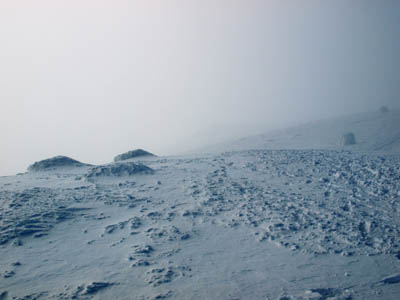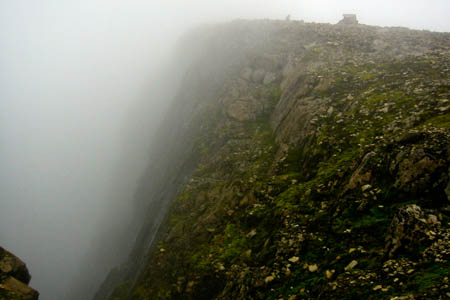
The scene on Ben Nevis's summit, where heavy snow accumulations have virtually buried some of the cairns
A mountain expert has warned walkers to take care on Britain’s highest mountain after prolonged winter snows left important navigation aids virtually invisible.
Heather Morning, mountain safety adviser with the Mountaineering Council of Scotland, said cairns erected recently have been almost buried, prompting the need for extra vigilance to avoid Ben Nevis’s 700m (2,300ft) cliffs. The safe route off the mountain plateau involves a dog-leg course around Gardyloo Gully, a precipitous drop just 20m from the main path.
Ms Morning said: “The three cairns which mark the change in bearing around the top of Gardyloo Gully are now virtually buried in snow. Careful attention should be paid to judging distance by pacing and walking on a bearing in poor visibility to descend off the summit plateau safely.”
A further complication for summit navigators in bad visibility is that a natural tendency to walk to the left to avoid the drops of the north face can lead unwary mountaineers close to Five Finger Gully, an equally perilous drop to the South-West near the top of the main path zigzags.

Gardyloo Gully in summer, with the summit cairn to the right
There is detailed advice on navigating the summit plateau on the Mountaineering Council of Scotland website.
Included in the advice are the words: “If you become disorientated during the ascent of Ben Nevis, consider whether it may be best to turn back.
“Ben Nevis will always be there – the important thing is to make sure you are too.”
Last week, Sport Relief celebrity Three Peaks challengers Kate Silverton and Phil Packer were praised by mountain rescuers when they took the decision to abandon their attempt on Ben Nevis’s summit despite being only 100m from the top of the mountain when conditions defeated them.
Heather Morning, mountain safety adviser with the Mountaineering Council of Scotland, said cairns erected recently have been almost buried, prompting the need for extra vigilance to avoid Ben Nevis’s 700m (2,300ft) cliffs. The safe route off the mountain plateau involves a dog-leg course around Gardyloo Gully, a precipitous drop just 20m from the main path.
Ms Morning said: “The three cairns which mark the change in bearing around the top of Gardyloo Gully are now virtually buried in snow. Careful attention should be paid to judging distance by pacing and walking on a bearing in poor visibility to descend off the summit plateau safely.”
A further complication for summit navigators in bad visibility is that a natural tendency to walk to the left to avoid the drops of the north face can lead unwary mountaineers close to Five Finger Gully, an equally perilous drop to the South-West near the top of the main path zigzags.
There is detailed advice on navigating the summit plateau on the Mountaineering Council of Scotland website http://www.mcofs.org.uk/ben-nevis-navigation.asp.
Included in the advice are the words: “If you become disorientated during the ascent of Ben Nevis, consider whether it may be best to turn back.
“Ben Nevis will always be there – the important thing is to make sure you are too.”
Last week, Sport Relief celebrity Three Peaks challengers Kate Silverton and Phil Packer were praised by mountain rescuers when they took the decision to abandon their attempt on Ben Nevis’s summit despite being only 100m from the top of the mountain when conditions defeated them.